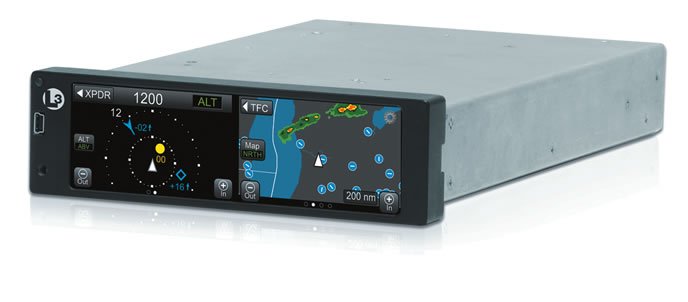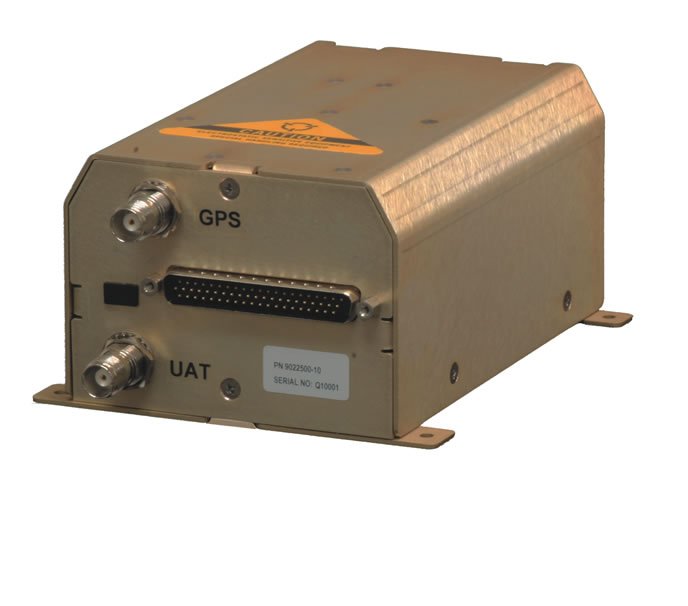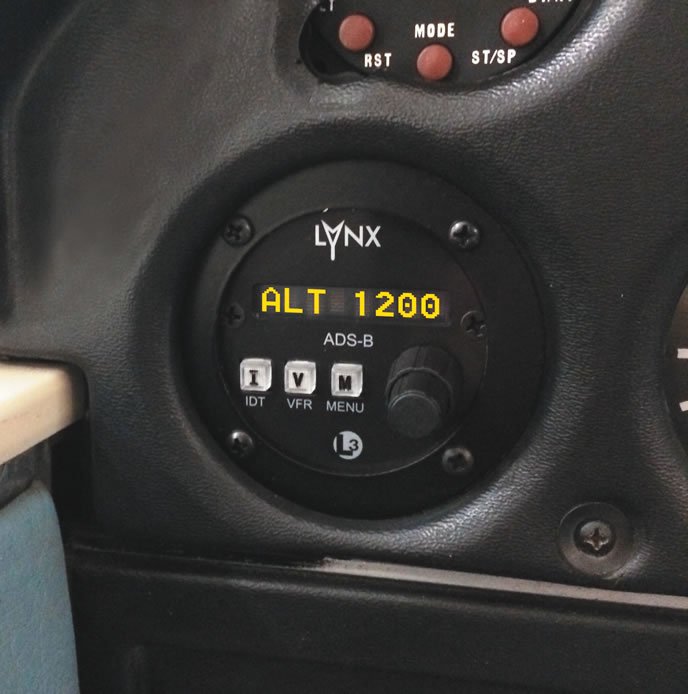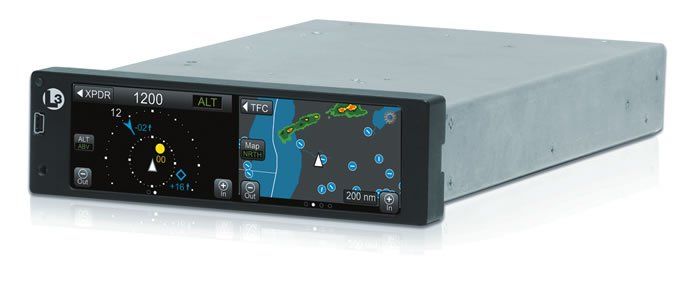If you have been holding off on an ADS-B upgrade for lack of choices, go directly to the mother of all ADS-B comparison charts on page 14. The choices are plentiful, while the interface limitations and compatibilities are overwhelming.
Adding to the mayhem is L-3 Aviation’s new Lynx ADS-B product line. L-3 says the MSS (for MultiLink Surveillance System) NGT9000 family of radio stack-mounted next-generation transponders is the primary market focus.
There are also several remote UAT transceivers in the Lynx MSS line, including the entry-level NGT1000 with its attention-getting $2500 price.

Smart transponder
Starting at $6800, the NGT9000 is a Mode S Class A1/A1S transponder with a built-in WAAS GPS receiver, dual-band ADS-B receiver and has 1090ES ADS-B output. It’s the first of its kind, particularly with a self-contained WAAS position source and a multifunction touch display.
The transponder comes in several models, including the base NGT9000, NGT9000D (dual-antenna, diversity-enabled model) and the flagship NGT9000D+, which adds an internal active TAS processor. It has an introductory list price of $11,933. The NGT9000+ has TAS, but not Diversity, and is $9200.
L-3 is a pioneer in TAS and TCAS technology with its popular Skywatch and Skywatch HP products, so it’s logical that TAS-equipped NGT9000 models can utilize existing Skywatch wiring and directional antenna. Those installations will benefit from the weight savings afforded by removing the large and heavy remote TAS processor.

An optional WiFi module enables wireless interface with iPad and Android tablets. L-3 has selected WingX Pro and SkyRadar for primary app compatibility, but says other interfaces are pending.
We like that the transponder supports multiple inputs/outputs, including ARINC 429, RS-422 and RS-232 serial data, plus discrete inputs/outputs for sensing whether the aircraft is on the ground or in the air.
While the architecture offers flexibility for cross-brand compatibility, the interface is limited by software. Since the TAS processor (and ADS-B traffic output) emulates the proven Skywatch interface, it should be possible to interface to a wide variety of panel displays, including Garmin products. It is worth noting that Garmin screens will not differentiate between TAS and ADS-B targets—all traffic will be painted in TCAS-like symbology.
The NGT9000 will track both TAS and ADS-B targets simultaneously, but displays the most accurate resolution. In general, targets having ADS-B output might be more reliable over one being interrogated by TAS.
The Lynx Tail function offers the flight ID, ground speed and class of surrounding ADS-B traffic.
The NGT9000 fits in a standard six-inch-wide radio stack and measures just under two inches high and is a similar footprint as the Garmin GTX330ES, Trig TT31 and Avidyne AXP340 1090ES transponders. The NGT9000R is a remote version designed for integrated glass cockpits.
But size is where the similarities end. Unlike the other 1090ES transponders which primarily have ADS-B output, the Lynx—with its dual-band (978 and 1090ES) ADS-B receiver—combines weather, traffic and navigation data on its color RGB touch display. Given the limitations of a bezel that measures under two inches tall, the device isn’t the optimum way to monitor traffic and weather data, in our opinion. A tablet computer could offer additional utility.
The internal WAAS GPS requires a dedicated GPS antenna and can’t be combined with an existing one. While Diversity models require a second directional antenna (for mounting on top of the aircraft), an existing Skywatch antenna can be used for Diversity and for TAS traffic.
The NGT9000 is controlled entirely by touch; there is no power switch. Instead, it powers on with the rest of the avionics when wired to an avionics master or battery switch. The system operates on 14 or 28 volts, making it a player for a wide variety of aircraft.
The data on the touch display is divided into left and right screens, which L-3 calls applications. You select each screen application using both drag and swipe actions, while basic screen position identifiers (hollow or empty circles) at the bottom of the screen show which page is active. Onscreen scroll bars navigate through lists or blocks of text, while slider bars are used for editing data and for increasing and decreasing numerical values, for example.

Onscreen command buttons are typically a gray background color with white or green text. When a button is pressed, its background is highlighted in blue. The logic also makes use of momentary—to perform a onetime function—and latch buttons, which are tapped to set a single function to on or off. Gear-shaped option buttons are used to access available options for a given application screen. Simply tap the button to open the list of options.
Since the NGT9000 serves as a primary transponder, there is a dedicated transponder application that shares the left screen (by toggling) with traffic alerting. It contains transponder squawk code, IDENT-reply, pressure altitude readout, transponder mode control (for selecting typical Mode A/C functions including altitude encoding), plus a MSG key that flashes when a new message is received. Simply tap it to view the message and tap Done to jump back to the application page. The ON-GND indicator advises that the transponder is operating in ground mode and isn’t replying to all interrogations.
On a side note, there are multiple installation options for sensing ground and air mode status, include a weight-on-wheels landing gear sensor, an airspeed sensor switch, or by using the internal GPS groundspeed and altitude data. The unit requires pressure altitude input via a serial altitude digitizer or traditional Gray code altitude encoder. It also has outputs for interfacing with compatible audio panels for traffic alerting and other prompts.
Multiple right-screen applications include a bird’s-eye traffic page, FIS-B graphics including NEXRAD radar, METAR, AIRMET, SIGMET and TFR data, all of which is overlaid on top of a basic map display.
The NGT9000 has a rich weather and traffic interface potential, and the sidebar on page 12 summarizes major applications. As we go to press, the NGT9000-series has not yet earned ADS-B TSO certification. L-3 says it has submitted the TSO request and expects approval later this spring. Installation approval will be governed by AML-STC.
Remote UAT options
The rest of the Lynx family includes remote-mount 978 MHz UAT devices. These are all equipped with internal, mandate-compliant WAAS GPS receivers.
The $3589 NGT2000 transmits ADS-B Out and receives ADS-B weather and traffic over the 978 MHz UAT frequency band. Through an optional $270 WiFi interface module, weather and traffic can be displayed on an iOS tablet through the WingX Pro app and on Android devices with the SkyRadar app. Like the NGT9000, L-3 says it is working with other app manufacturers to expand compatibility.
The $3856 NGT2500 has the same hardware and firmware/software as the NGT2000, but has an input/output protocol for interfacing with panel displays. This is where it gets sticky because many buyers will assume the device will play with an existing display, including the Garmin GNS430/530. It does not.
While the device outputs non-proprietary ARINC429, RS232 and RS422 data labels, it still relies on third-party software compatibility to solidify the interface. L-3 said it tested the unit on a Garmin-AT GMX200 and earlier MX20—a display that dates back to the Alaskan Capstone project—a time and place where the liberal, open architecture was created, but since abandoned by Garmin.
The $2521 entry-level NGT1000 doesn’t require a display because it doesn’t have an ADS-B receiver. It does have a built-in WAAS GPS and is currently in certification, while the NGT2000/2500 are approved.
The NGT2500/2000/1000 products do not come with ADS-B or WAAS GPS antennas, so these need to be sourced by the installer. On average, this hardware could add roughly $900 to a project, plus install.
The other accessory that isn’t included with any of the Lynx UAT devices is the $1223 CP-2500 remote ADS-B control panel. Since mandate-compliant ADS-B interfaces require that the ADS-B device transmits a squawk code and IDENT just as Mode A/C transponder does, the main function of the control panel is alerting the operator when there is a discrepancy between the two devices. It also enables the operator to manually sync the two.
Garmin’s GDL88/84 series ADS-B systems eliminate the control panel with a self-contained low-power 1030 MHz transmitter that interrogates the transponder. The transponder reply enables both systems to remain in sync. In our view, this is a sizable advantage.
The control panel isn’t required if the interface includes a Garmin GTX327, GTX330 or Avidyne AXP340 digital transponder, since this syncing is accomplished over the transponder’s RS232 serial databus.
The control head shouldn’t require much effort to install, since it is designed to fit in a standard 2-inch instrument cutout. But if the panel doesn’t have an empty hole, the shop has to cut one.
Conclusion
The fly in the ointment is the Lynx’s inability to display FIS-B data on common panel displays, at least not yet. L-3’s Steve Rutherford is optimistic for future widespread compatibility, based on such success with previous interfaces.
“We believe the demand for Lynx will encourage the display manufacturer’s to accept this non-proprietary signal and permit the data to display on multiple units. We experienced a similar situation when we developed SkyWatch and Stormscope to port data onto other manufacturer’s displays (Garmin, Aspen, Avidyne), and the demand persuaded the manufacturers to accept the data,” Rutherford told us.
We asked Garmin where it stands when it comes to participating in third-party ADS-B interfaces, including evolving solutions like the Lynx.
“Given there are no published industry standards for ADS-B display interfaces, we have developed our own proprietary interface which is only compatible with our own ADS-B products,” said Garmin’s Jessica Koss.
The basic NGT9000 transponder could likely top $9000, after installation, while the TAS and Diversity-enabled NGT9000D+ could approach $15,000. At these prices, we think the system will be limited to higher-end aircraft, particularly those that require 1090ES above 16,000 feet.
The $2521 NGT1000 is an expensive mandate-compliant transmitter, but a complicated installation that requires the control panel and new antennas could yield a bottom line that approaches, if not exceeds, $5000. For that reason, we think the NGT2000, Garmin GDL84 and FreeFlight RANGR 978 could be the better choices, as they will all display free ADS-B weather and traffic. The way we see it, the added capability lessens the sting of an investment that still isn’t cheap enough to be a game-changer. Contact www.l-3lynx.com, 800-253-9525.





